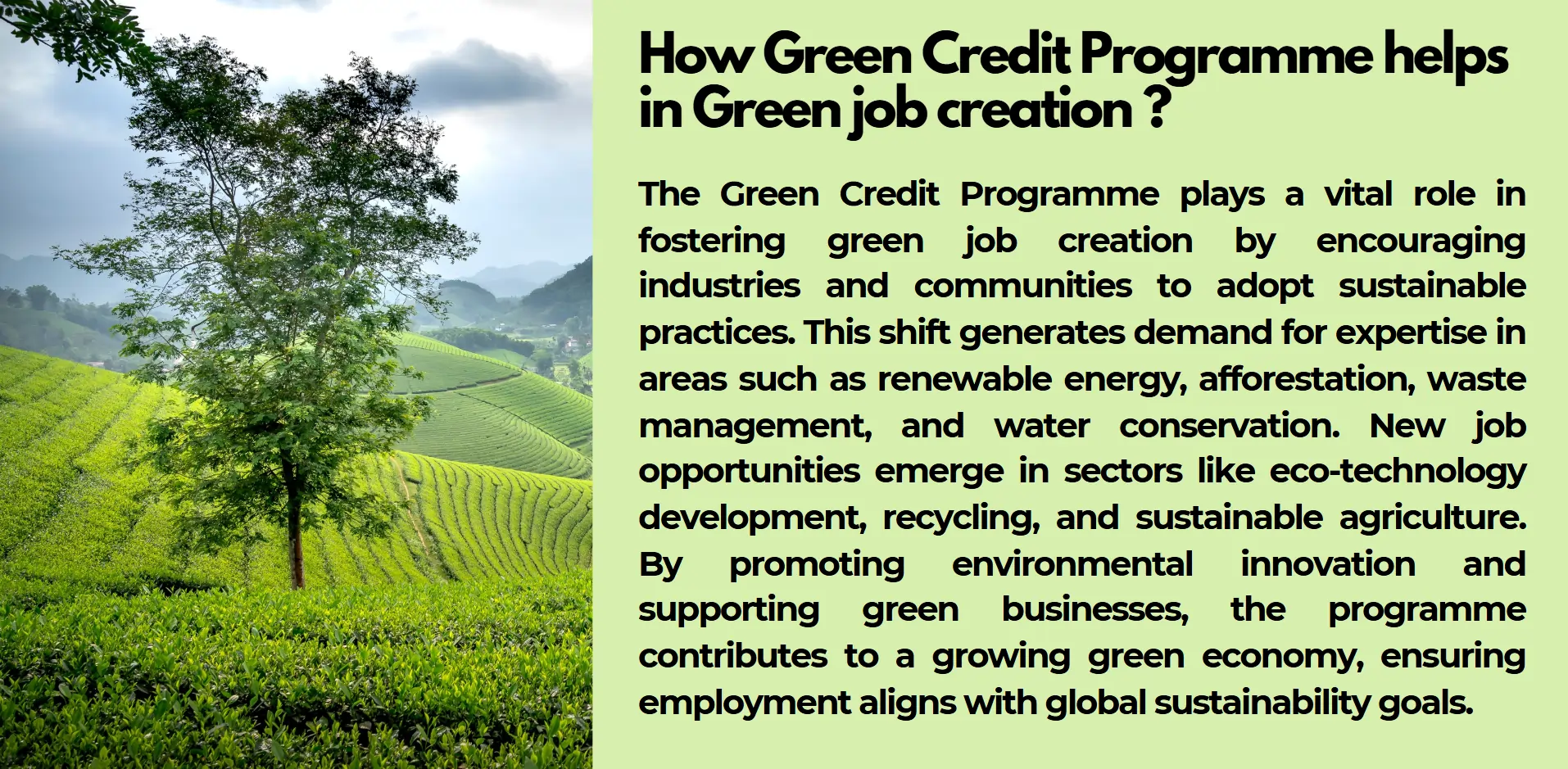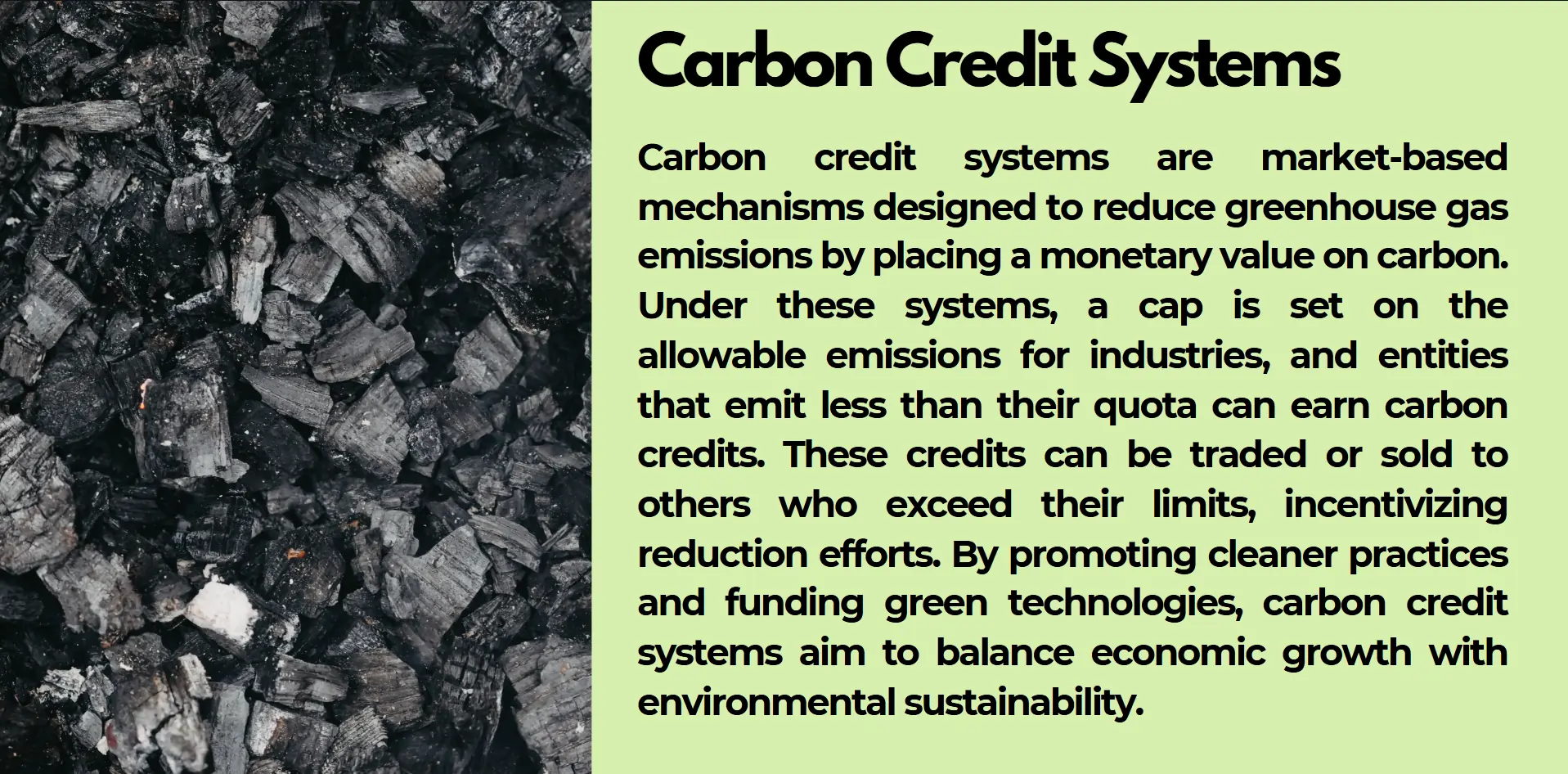The plan provides tradable credits to motivate people to voluntarily participate in water conservation activities and plantation management.

Currently society focuses on the Green Credit Programme as a progressive model which offers environmental sustainability incentives to promote green practices. The program provides credits to activities that preserve resources and protect the environment to motivate all sectors including industrial, local and individual groups to join. The innovative framework of this program has received applause while serving as an important strategy to address global warming and protect the environment. The scheme encounters multiple forms of criticism when examined under its status as a transformative policy despite its recognition of valuable benefits. The article investigates both the operational aspects of the Green Credit Program together with its promising outcomes even though it confronts serious opposition.
Understanding the Green Credit Programme
The Green Credit Programme introduces a ground-breaking method to boost environmental conservation practices because preserving nature has become mandatory for our current era. The scheme operates as part of comprehensive climate action approaches by recognizing eco-friendly practices of individuals combined with industrial activities and community contributions leading to environmental protection.
The main concept of the Green Credit Programme rests on granting credits after confirming eco-friendly actions. Participants acquire green credits through their involvement in forest creation projects alongside renewable energy system adoption and waste management work along with water conservation and decreasing environmental carbon output. Credits represent concrete proof of successful participation that enables economic return through transactions such as cost reduction services for industry operations. Stakeholders find clear motivation through this framework since it encourages their organizations to embrace sustainability objectives.
A variety of businesses together with medium and large corporations and separate individuals can participate within this broad program framework. The program establishes pathways through which large numbers of society members can actively advance climate action programs. The program provides special incentives for industries known for generating substantial emissions since their transformation into eco-friendly operations becomes a top priority. The program actively recognizes traditional conservation practices among communities because they dedicate their efforts to maintaining inclusivity.
A distinctive aspect of the Green Credit Programme involves measuring its results. Provided evidence about their eco-friendly practices must be verified through independent review procedures to maintain program authenticity. The scheme's desirable effectiveness depends on effective fraud prevention for authenticating claims through this programmatic mechanism.
Research shows that this program will result in positive outcomes. The program possesses environmental advantages such as decreased carbon emissions and habitat preservation alongside potential economic change effects. Through developing the green economy sectors it should create multiple new employment positions in renewable energy generation, waste recycling and sustainable agricultural practices. Through this initiative environmental knowledge spreads to the general public which results in developing sustainable behaviour patterns for daily routines.
However, the success of the Green Credit Programme hinges on robust implementation, transparent governance, and equitable access. The Green Credit Programme's potential to fully deliver its sustainability promise depends on its ability to balance conflicting interests and bring success in the long-term period. This policy serves as a major development that establishes connections between environmental measures and economic benefits.
Benefits of the Green Credit Programme
Through its Triple Green Credit Program the diverse set of advantages aims to develop sustainable practices and resolve major environmental problems. The program awards environmentally conscientious activities which stimulates people and organizations to genuinely support ecological maintenance activities. This initiative surpasses environmental improvements at the core to generate sustained impacts on society plus the economy.
Environmental Advantages
The main purpose of this program is to minimize adverse environmental damage. Through its implementation of waste management alongside renewable energy adoption and afforestation practices the program effectively tackles environmental problems including resource deficit and carbon pollution and deforestation. The incentive system in place encourages participants to choose environmentally friendly alternatives which generate positive effects such as better air quality alongside water quality improvements, biodiversity preservation and climate change reduction.
Economic Transformations
The Green Credit Programme functions as a driving force that leads economies toward sustainable direction. The growth in market demand for green technology encourages sector-wide innovation within renewable power generation alongside waste management and sustainable farming procedures. Green job creation becomes possible through this program because it follows the emerging global trend toward building a green economy. Businesses can achieve operational cost reduction through credits provided in the programme facilitation of sustainable model adoption.

Social Impact
As a major program achievement the environmental consciousness of community members increases because of its public outreach efforts. The involvement of different stakeholders from industries and individual participants drives collective movement toward sustainable development. The inclusive program enables recognition and compensation of traditional eco-friendly community practices thus empowering their members through its framework.
Criticisms and Controversies
The Green Credit Programme receives praise for its conceptual approach yet people have pointed out substantial objections to its operation. The implementation method and strategy of this program face critical challenges which trigger discussions about its operational efficiency and distributional equality.
Economic Concerns
The financial aspects of the program face considerable criticism as the main objection against it. The implementation expenses along with maintenance costs for such a system tend to surpass its documented advantages according to those who criticize the approach. The program creates obstacles for small and medium enterprises (SMEs) because their limited resources cannot fulfil the requirements within the program framework. The program functions as a challenge for small and medium enterprises (SMEs) because their restricted financial capabilities fail to meet the requirements of the program framework. The program faces credibility issues because it creates potential disadvantages for particular stakeholder groups.
Social and Ethical Issues
The initiative faces criticism because it enables different groups to access its features in unequal ways. Organizations with superior financial resources and technological capabilities tend to achieve better results in the program without considering groups that have limited resources. The organization faces a sustainability marketing risk that stems from their excessive claims about environmental commitments to earn credits but demonstrates limited real sustainability activities. The worth of this framework declines because multiple entities lose their credibility.

Environmental Limitations
According to environmental researchers the sustainability of this program appears unsustainable environmentally. Environmental regulators believe the carbon credit program encourages organizations to secure credits instead of taking direct actions and thus enables entities to reach their environmental requirements through financial transactions. The scheme demonstrates limited ability to handle fundamental environmental problems that need comprehensive changes within society rather than independent projects.
Various examination points about the Green Credit Programme request precise stewardship, fair entry standards and lasting supervision to retain its role in sustainable practices. To achieve maximum impact and prevent negative side effects the program needs proper resolution of these issues.
Comparative Perspective
The Green Credit Programme exhibits direct compatibility with worldwide sustainability initiatives since they deliver feedback regarding their effects and present ways to enhance performance. Stakeholders can learn through comparative evaluation about the established best practices of other countries while finding difficulties within these schemes during international practice reviews.
Carbon credit systems operate in the European Union nations and Canada making them a relevant benchmark for evaluation. Industrial carbon emissions receive regulation through these systems since they enforce emission standards and allow industries to exchange excess emission credits. The Green Credit Programme implements its framework through a mechanism of credit exchange as motivators. Under carbon credit systems only industrial emissions receive attention but Green Credit Programme extends to various actions including tree planting as well as water preservation and waste disposal projects. Different environmental issues throughout India match the system's principles yet their combined nature makes tracking and execution more complicated.

India showcases similar approaches to EU by implementing Green Finance initiatives based on environmental integration within its financial sector. The policy structure provides green bonds and loans which promote funding opportunities for sustainable development initiatives. The Green Credit Programme of India seeks to encourage sustainable practices by directly involving local communities as well as individuals throughout the country. The inclusive design which tackles socio-environmental issues creates obstacles when maintaining equal access and participation for all.
International systems provide important knowledge through their observed weaknesses. The public carbon market system has gained negative attention because it creates unequal situations between wealthy and less fortunate nations. The Green Credit Programme in India faces the risk of benefiting more the big industrial corporations with abundant resources compared to smaller enterprises that take part in its framework.
Recommendations and Future Scope
The suggested modifications to the implementation model enable the Green Credit Programme to produce superior results and prevent operational boundary challenges. The recommended changes enable objective fulfilment for the program along with maintaining operational efficiency while supporting open transparency and unbiased procedures. The future examination of program will transform the Green Credit Program into India's main sustainable development mechanism.
Recommendations
Strengthen Monitoring and Verification
Software monitoring solutions must be created to prevent breaches of program integrity since they occur while sustaining program genuineness. Through block-chain technology combined with satellite monitoring the program creates an open credit monitoring framework that functions with environmental verification platforms.
Promote Accessibility and Inclusivity
Wider program accessibility depends on developing inclusive communication systems that especially benefit underprivileged stakeholder groups and micro business owners. The program needs to implement fundamental systems that link to funding support as well as development initiatives in order for disadvantaged citizens to participate effectively.
Address Financial Barriers
Small business stakeholders require financial support from the government which should include funding programs linked with subsidy programs and decreased interest rates. The government-developed financial assistance programs reduce sustainable practices' implementation costs to ensure widespread adoption.
Establish Clear Guidelines
Government agencies should create standardized definitions together with specific activity requirements for distributing credits in a consistent manner and maintaining clear procedures.
Foster Public-Private Collaboration
Public and private organizations with non-governmental units need to collaborate with the government to improve how they implement processes. Participating corporations achieve greater financial support through their action because they contribute unique strategies which augment funding benefits.
Raise Awareness
Initiatives that spread awareness about the benefits of the program will create more positive interest among citizens to take part. Multiple institutions combining educational organizations and local communities should develop an environment which promotes sustainability goals.
Future Scope
India will forward its environmental progress through an adaptable system that builds up the Green Credit Programme. Future developments of the program must move past existing domains by integrating initiatives for urban forest establishment and EV implementation with circular economy development. The country will attract global sustainability investments through accepting carbon trading frameworks integrated with global sustainability frameworks to become a leading sustainable nation.
The research program needs extensive integration of technological elements to achieve its goals. Real-time data analytics systems used with artificial intelligence capabilities along with mobile applications create efficient streamlined processes that enhance user interaction while improving participant efficiency. The program should offer financial benefits for studying environment-friendly technologies because this will drive innovation across the entire green sector.
International guidelines are demonstrated by the Green Credit Programme through its method of responding to new environmental challenges while employing tested global best practices. Sustainability of the program depends on collective stakeholder engagement as they guide economic development to protect the environment for a lasting future.
Conclusion
Current data demonstrates that the Green Credit Programme stands as an extensive program that combines environmental preservation with advantageous economic practices and social returns for organizations. The program shows strong potential for solving critical environmental problems because it develops responsible sustainable practices across all sectors. The Green Credit Programme requires solution to its existing reach limitations and cost barriers in order to establish enduring environmental sustainability. The framework will produce its maximum impact with committed governance systems that unite inclusive management techniques and technological integration. India can lead its sustainability movement through the Green Credit Program which demonstrates the capability of innovative solutions to shape a peaceful coexistence with nature.